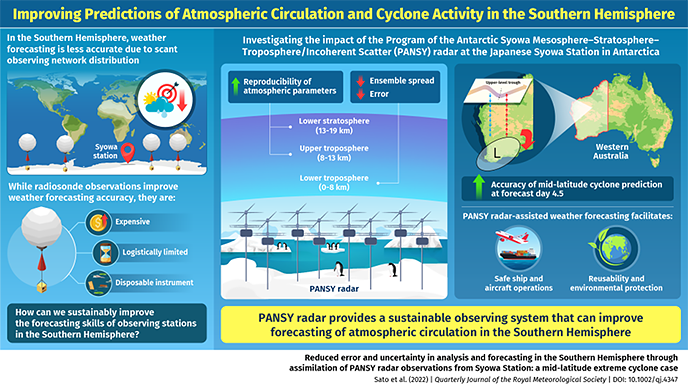National Institute of Polar Research
Towards Better and Sustainable Weather Forecasting in the Southern Hemisphere
Data from a radar at the Japanese Syowa Station in the Antarctic improved forecasting of atmospheric circulation and mid-latitude cyclones
August 23, 2022
The mid- and high-latitude region of the Southern Hemisphere suffers from erroneous weather forecasting owing to insufficient observation networks, particularly in the Antarctic. While radiosonde observations are an option, they are costly and environmentally hazardous. Now, researchers from Japan have addressed this gap, showing that the forecasting accuracy can be continuously improved and made sustainable through the implementation of observation data from the PANSY radar at Syowa Station in the Antarctic.

Figure: Improving Predictions of Atmospheric Circulation and Cyclone Activity in the Southern Hemisphere. In a new study, researchers from Japan propose a sustainable approach to improving forecasting skills of observing stations in the Southern Hemisphere by implementing data from the PANSY radar located at Syowa Station in the Antarctic region. Credit: Kazutoshi Sato from Kitami Institute of Technology
Studying atmospheric circulations is essential for predicting weather conditions and preparing for future weather disturbances. In the Southern Hemisphere, meteorological observing stations have been implemented for analyzing the weather conditions. However, owing to their scattered distribution over the Antarctic, the observational data is often riddled with errors and uncertainties that hamper the reproducibility of atmospheric circulations in the region.
One way to improve the forecasting accuracy is by using observation data from a radiosonde, a battery-powered telemetry instrument carried into the atmosphere by a weather balloon. While this reduces uncertainty and error in weather forecasts, radiosondes are expensive, logistically limited, and environmentally hazardous since they leave waste over the land and ocean. This raises an important question: is it possible to improve weather forecasting predictions in the Southern Hemisphere in a sustainable manner?
In a new study published in the Quarterly Journal of the Royal Meteorological Society, a team of researchers from Japan led by Assistant Professor Kazutoshi Sato from Kitami Institute of Technology may now have an answer. In their work, they have demonstrated, using an observing system experiment, that incorporating radar data observations from the Japanese Syowa Station in the Antarctic enhances the reproducibility of atmospheric parameters in the troposphere and lower stratosphere. These are the parameters that serve as the initial conditions for forecasting. The work included contributions from Jun Inoue and Yoshihiro Tomikawa from National Institute of Polar Research, Akira Yamazaki from Japan Agency for Marine-Earth Science and Technology, and Kaoru Sato from The University of Tokyo, all in Japan.
But, what is so special about this radar? Called “The Program of the Antarctic Syowa Mesosphere–Stratosphere–Troposphere/Incoherent Scatter” or PANSY, this radar uses a pulse-modulated monostatic Doppler radar with an active phased array of 1045 crossed-Yagi antennas that measures vertical profiles of wind speed in the altitude range of 1.5 – 22 km (lower troposphere to lower stratosphere).
The team assessed the impact of 1-hourly horizontal wind speed data obtained from the PANSY radar for predicting a mid-latitude cyclone close to Western Australia and compared it with forecast experiments that did not include PANSY data as initial conditions.
They found that forecasts using PANSY data had reduced errors in the upper troposphere over the Antarctic region. This, in turn, increased the prediction accuracy for the position of the surface cyclone over Western Australia at forecast day 4.5. Interestingly, the error near Syowa Station at the initial time of forecast grew with time and propagated from Antarctica to southwestern parts of Australia. “This shows that the PANSY radar data would benefit the forecast accuracy of the cyclone near southwestern Australia for forecast between 4.0 and 5.0 days,” highlights Dr. Sato. Additionally, the PANSY radar data can be reused and does not cause environmental waste like a radiosonde.
These findings suggest that weather forecasting over the Antarctic can be augmented to a large extent and continuously with PANSY data. Moreover, it does not entail any environmental hazard. The team concludes, “Enhanced accurate weather forecasting over the Southern Ocean with PANSY would contribute not only to the safety of ship and aircraft operations around the Antarctic but also to the reduction of human and socioeconomic damage over mid-altitude areas of the Southern Hemisphere.”
Original article:
Journal: Quarterly Journal of the Royal Meteorological Society
Title: Reduced error and uncertainty in analysis and forecasting in the Southern Hemisphere through assimilation of PANSY radar observations from Syowa Station: a mid-latitude extreme cyclone case
Authors:
Kazutoshi Sato (Kitami Institute of Technology, Japan)
Jun Inoue (National Institute of Polar Research, Japan)
Akira Yamazaki (Japan Agency for Marine-Earth Science and Technology, Japan)
Yoshihiro Tomikawa (National Institute of Polar Research, Japan)
Kaoru Sato (The University of Tokyo, Japan)
DOI: 10.1002/qj.4347
URL: https://doi.org/10.1002/qj.4347
Published: August 23, 2022 (JST)
Funder:
This study was supported by a JSPS Overseas Research Fellowship, JSPS KAKENHI
(22K14103, 22H00169, 20H04963, 19K14802, 18H05053), ROIS-DS-JOINT (017RP2022) and, as a part of the Science Program of the Japanese Antarctic Research Expedition (JARE), was supported by the National Institute of Polar Research (NIPR) under MEXT.








